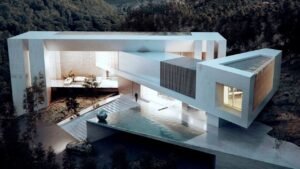The Influence Of Modern Day Architecture In Today’s Society
Modernism (Modern Day Architecture) is a fascinating architectural form that draws on utopian concepts, creativity, and a reinvention of how people would live, work, and communicate.
Despite coexisting between 1910 and 1930, the Expressionist style’s biomorphic, organic, emotional forms stood in stark contrast to Bauhaus architecture’s clean, linear definitions.
Expressionism, which was influenced by the German, Dutch, Austrian, Czech, and Danish Avant-Garde, looked into new technical possibilities that came from mass production of steel, brick, and glass, as well as other materials.
Functionalism, Minimalism And Styles – Modern Day Architecture

The International Style’s clean lines and functionalism’s reduced utilitarianism were becoming increasingly popular in American and European cities by the mid-twentieth century. Postmodern architecture arose from a complete rethinking of basic modernist ideas, and it was part of a conceptual movement that was just as broad as the Modernism it intended to replace. The De Stijl and Bauhaus movements of the 1920s influenced minimalism, which emphasised the use of simple design elements without embellishment or decoration. The approach, which was popularised by architects like Mies van der Rohe, suggested that stripping a design down to its bare bones reveals its actual core. Pure geometric forms, plain materials, repetition, and clear lines are all characteristics of the style. The International Style was coined in 1932 at the Modern Architecture International Exhibition by curators Philip Johnson and Henry-Russell Hitchcock. The International Style depicts the period when European Modernism extended around the world, particularly in the United States, as an outgrowth of early Modernist concepts in Europe. The style is characterised by plane geometry and a lack of decoration.
Deconstructivism
Deconstructivism is a postmodernist movement that emphasises the lack of harmony, continuity, and symmetry in architecture. Deconstructivism frequently manipulates a structure’s surface skin, creating non-rectilinear geometries that deform and dislocate parts, expressing unpredictability and controlled chaos. In the 1980s, the look became popular.
Written By Ankit Lad | Subscribe To Our Telegram Channel To Get Latest Updates And Don’t Forget To Follow Our Social Media Handles Facebook | Instagram | LinkedIn | Twitter. To Get the Latest Updates From Arco Unico
